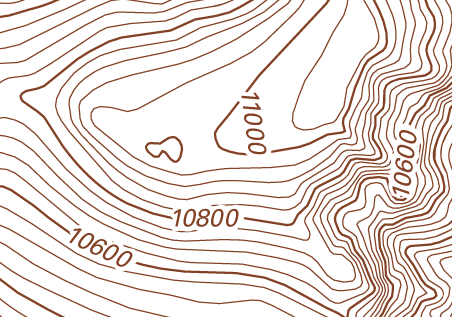

In general, the forces acting to move prostheses toward and across the supporting teeth and/or tissue are the greatest in intensity. As was mentioned in Chapter 4, the direction of forces can be toward, across, or away from the tissue. When one is dealing with a crown or fixed partial denture, the combined use of preparation geometry (i.e., resistance and retention form) and a luting agent can fix the prosthesis to the tooth in a manner that resists all forces to which the teeth are subjected. Retention of a removable prosthesis is a unique concern when compared with other prostheses.

Have students identify each of the human-made features below and its symbol.Įncourage students to use what they learned about symbols to identify natural features and their symbols too.Direct Retainer’s Role in Control of Prosthesis Movement Then ask students to use those symbols to identify other human-made features on the contour map of your area.
Height of contour definition pdf#
Use symbols to identify other features on the contour map of your area.ĭisplay the USGS Topographic Map Symbols PDF for students. Have them subtract the lowest number from the highest to figure out the height of that landform.Ĥ. Have students read the contour lines at the bottom and top of the highest place in your area. If the local relief is relatively flat, emphasize variation rather than extremes between steep and flat.

Explain that the space indicates the elevation is not changing much those are flat places. Then have students pinpoint a place where the contour lines are far apart. Explain that the close lines mean the elevation is changing rapidly those are steep places. Have students pinpoint a place where the contour lines are close together. Tell students that by reading contour lines, they can measure the steepness of a hill, the height of a mountain, and even the depth of a lake or ocean. Explain to students that these are imaginary lines that join points of equal elevation, and that they allow you to read the shape of the Earth’s surface. Use the Nat Geo Topo! Explorer website to find and display a contour map of your area. Sources: who provided information for the map Index: the part of the grid where specific information can be located Orientation: direction (north arrow or compass rose) Write the acronym on the board and explain to students that most topographic maps include these map essentials: Ask students if they have ever heard the acronym DOGSTAILS. Remind students that an acronym is a word formed from the first letters of other words. Ask: Why might this be useful? Elicit from students that contour maps are a convenient way to visualize flat and steep terrain, especially for hikers or other people navigating with maps. Explain to students that relief is the amount of elevation change in the land surface within a given area.Įxplain to students that a contour map is another name for a topographic map, or a map that shows the elevation of land on a flat paper surface. In the flatter areas, elevation doesn’t change as much.

Tell students that in hilly and mountainous areas, the elevation of the land changes within the area-sometimes very quickly. Explain to students that those differences are elevation changes. Ask: What is the main difference between hilly or mountainous terrain and flat terrain? Students should point out the differences in height. Sketch simple line drawings of each on the board. Brainstorm a list of common landforms.Īsk students to name some common landforms, such as hills, mountains, valleys, and plateaus.


 0 kommentar(er)
0 kommentar(er)
